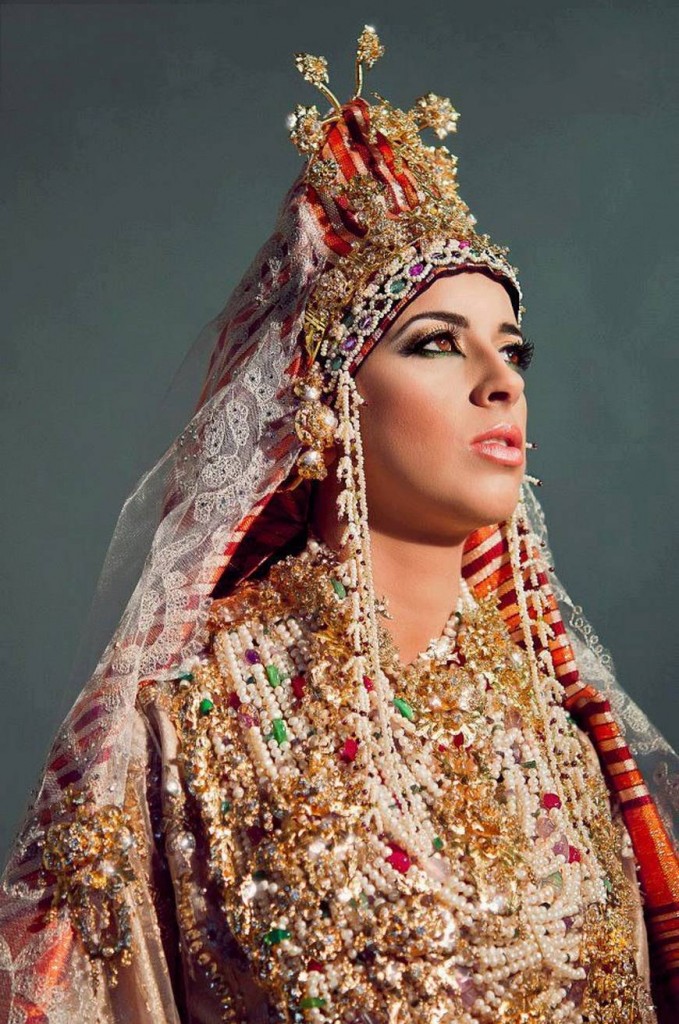Creation by Ziana Zahara Styling - Chedda Tetouania
In the middle of the terrace of a house in the centre of the town of Taza, a hundred kilometres from Oujda, one could make out a caïdal tent illuminated by lanterns.
From afar, songs of praise to the Prophet and youyous could be heard.
Under the porch of the house, two men, elegantly dressed, stood solemnly.
They greeted the guests with a big smile and welcome messages.
These gentlemen are none other than the husband's father and paternal uncle.
In a large room, fitted out and decorated for the occasion, covered tables with beautiful white tablecloths are arranged in a semicircle.
Around them, about a hundred guests are seated on beautifully decorated wooden chairs.
Wedding Ceremony
Opposite, two armchairs, in gold brocade, are reserved for the bride and groom.
On the Right, a five-piece orchestra played a melodious tune.
The entire audience was eagerly awaiting the arrival of the bride.
It's eleven o'clock at night and the party is slow to start. At that moment, horns sound. The bride and groom are finally here.
On a gold-plated canopy, carried by four men in moroccan jabador The bride, Nawal, was making her entrance.
Walking beside the convoy, hesitantly stepping and scanning the ground, the husband, Mohamed, was dressed in the same way as the porters.
Guests were clapping, youyous were pouring in from all over the place.
The band started a song to welcome the new couple.
Young girls, probably relatives, were throwing flowers and rice at the procession.
Some young girls who wanted to set the mood performed a few dance moves.
The atmosphere was relaxed as the orchestra sang popular tunes
Dinner time was approaching. A woman of advanced years was whispering a few sentences in the ears of the guests.
Information taken, she invited them to go downstairs to eat.
The mechoui and lemon chicken will only be served to the privileged.
The negafa (matchmaker), the woman of the ceremony, took care to post one of her collaborators to ensure that the ban was respected.
Nawal had to wear a new outfit each time... takchita and adorn themselves with new gold-plated jewelry supplied by the negafa.
Sometimes in Berber outfit, sometimes in Ujdi outfit called Karakou, a kind of seroual with a tunic embroidered in gold thread, sometimes in fassiea pyramid-shaped outfit, heavy to wear.
But the most amazing thing is the Indian outfit, sari.
The usefulness of the latter remains incomprehensible.
It only serves to ridicule the bride.
At the end of the evening, the fateful moment arrived.
The young couple were to retire to the bridal chamber to consummate their marriage.
As the brides locked themselves in, the convoy accompanying them stayed behind the door.
As the minutes went by, the crowd lost patience.
Youyous
The bride's parents were livid, while Mohamed's family stared at them.
Their eyes were already sparkling.
The tension subsided. Youyous resounded. Songs praising the bride's virtue and the groom's virility were heard.
The father of the bride chose this moment to perform dance steps. An air of relief could be read on the faces.
In the early morning, Mohamed joined the two families to share this moment of happiness around a bowl of "harira".
As for the bride, we didn't see her again. And no one was looking after her. She did her job with dignity.
That's the most important thing. Her mother took care of the "sheet" which she sprinkled with salt and kept carefully. The next day she will show it to the guests who will come to ask about the news.
Ladies and gentlemen, this Moroccan wedding was celebrated last month in an average Moroccan family.
Nawal is an instructor and Mohamed is a civil servant in a Taza administration.
Don't be surprised, it's still with us.
Maroc Hebdo International, Morocco

